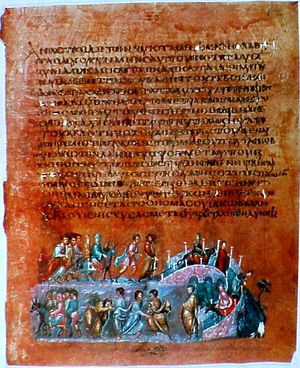Vienna Genesis: Difference between revisions
imported>David Stapleton (New article, 6th century manuscript) |
mNo edit summary |
||
| (3 intermediate revisions by 3 users not shown) | |||
| Line 1: | Line 1: | ||
{{subpages}} | |||
[[Image:ViennGenFol12vJacob.jpg|thumb|Folio 12 verso. The story of Jacob.]] | |||
The '''Vienna Genesis''' ([[Vienna]], [[Österreichische Nationalbibliothek]], cod. theol. gr.31) is an [[illuminated manuscript]], probably produced in [[Syria]] in the first half of the [[6th Century]]. It is the oldest well-preserved, surviving, illustrated biblical [[codex]]. | The '''Vienna Genesis''' ([[Vienna]], [[Österreichische Nationalbibliothek]], cod. theol. gr.31) is an [[illuminated manuscript]], probably produced in [[Syria]] in the first half of the [[6th Century]]. It is the oldest well-preserved, surviving, illustrated biblical [[codex]]. | ||
| Line 12: | Line 16: | ||
*Weitzmann, Kurt. ''Late Antique and Early Christian Book Illumination''. New York: George Braziller, 1977. | *Weitzmann, Kurt. ''Late Antique and Early Christian Book Illumination''. New York: George Braziller, 1977. | ||
[[Category: | [[Category:Suggestion Bot Tag]] | ||
Latest revision as of 07:01, 5 November 2024
The Vienna Genesis (Vienna, Österreichische Nationalbibliothek, cod. theol. gr.31) is an illuminated manuscript, probably produced in Syria in the first half of the 6th Century. It is the oldest well-preserved, surviving, illustrated biblical codex.
The text is a fragment of the Book of Genesis in the Greek Septuagint translation. The text is frequently abbreviated . There are twenty-four surviving folios each with a miniatures at the bottom of both sides. It is thought that there were originally about ninety-six folios and 192 illustrations. It is written in uncials with silver ink on calfskin parchment dyed a rich purple. This shade of purple dye was also used to dye imperial cloth.
The illustrations are done in a naturalistic style common to Roman painting of the period. The manuscript's illustrations are, in format, transitional between those found in scrolls and later images found in codices. Each illustration is painted on a single page. However, within a single illustration, two or more episodes from a story may be included, so that the same person may be represented multiple times within a single illustration. There are both framed and unframed illustrations. The illustrations contain incidents and people not mentioned in the text of Genesis. These incidents are thought to have been derived from popular elaborations of the story or from a Jewish paraphrase of the text.
The Vienna Genesis may have been produced in the same period and place as the Rossano Gospels and the Sinope Gospels.
References
- Calkins, Robert G. Illuminated Manuscripts of the Middle Ages. Ithaca, New York: Cornell University Press, 1983. pages 21-22.
- Weitzmann, Kurt. Late Antique and Early Christian Book Illumination. New York: George Braziller, 1977.
